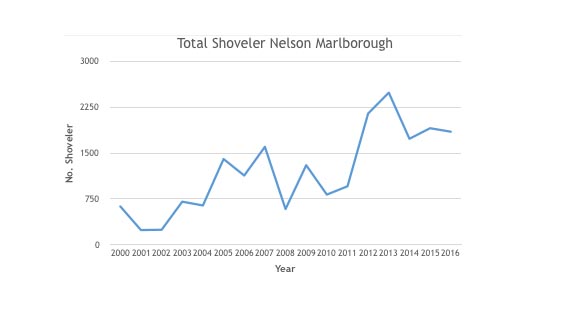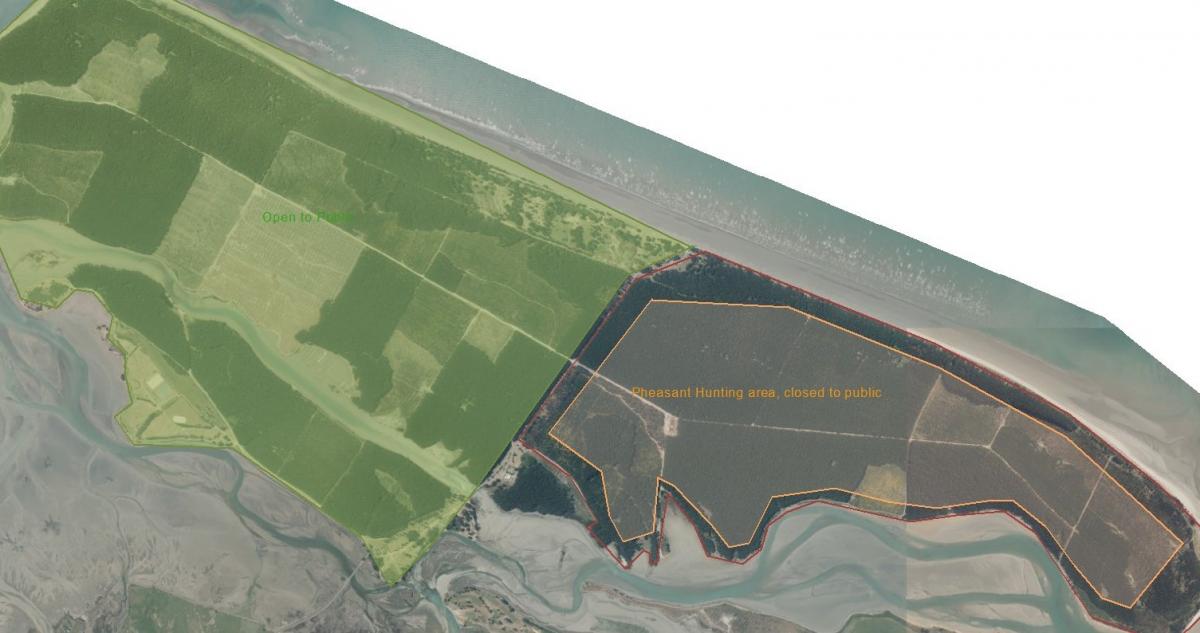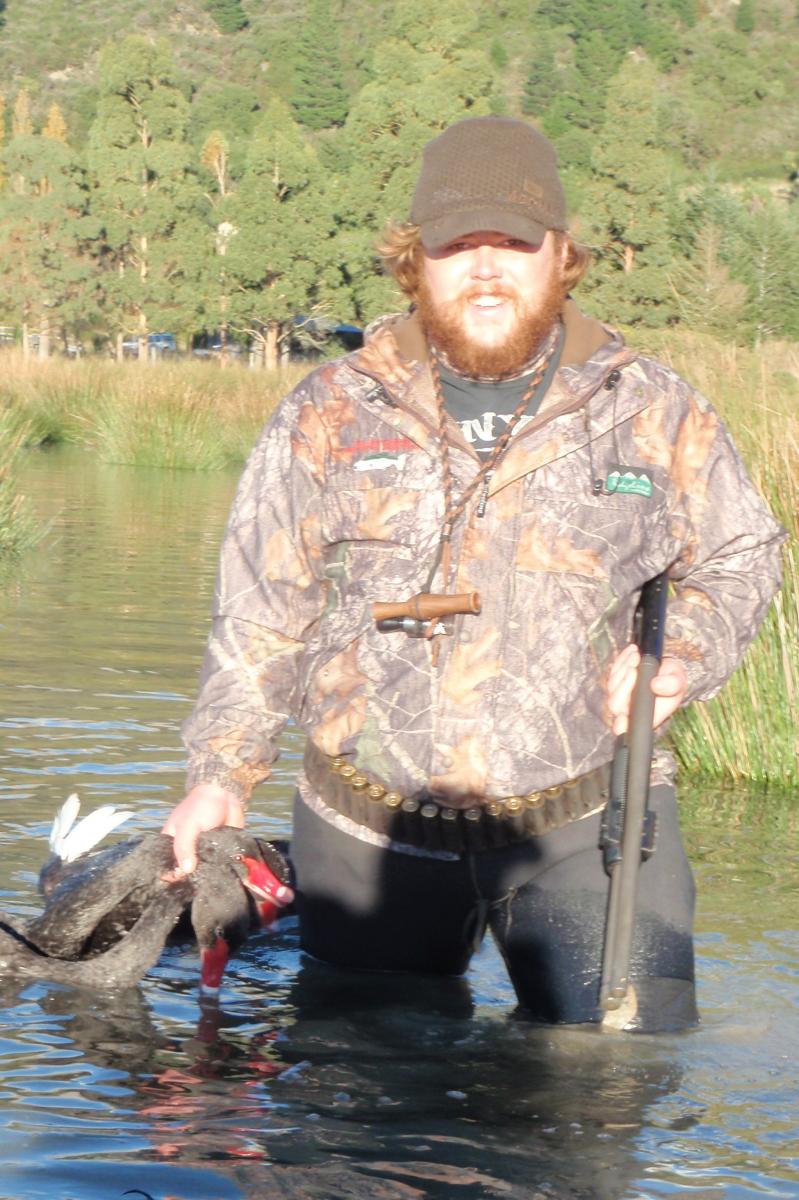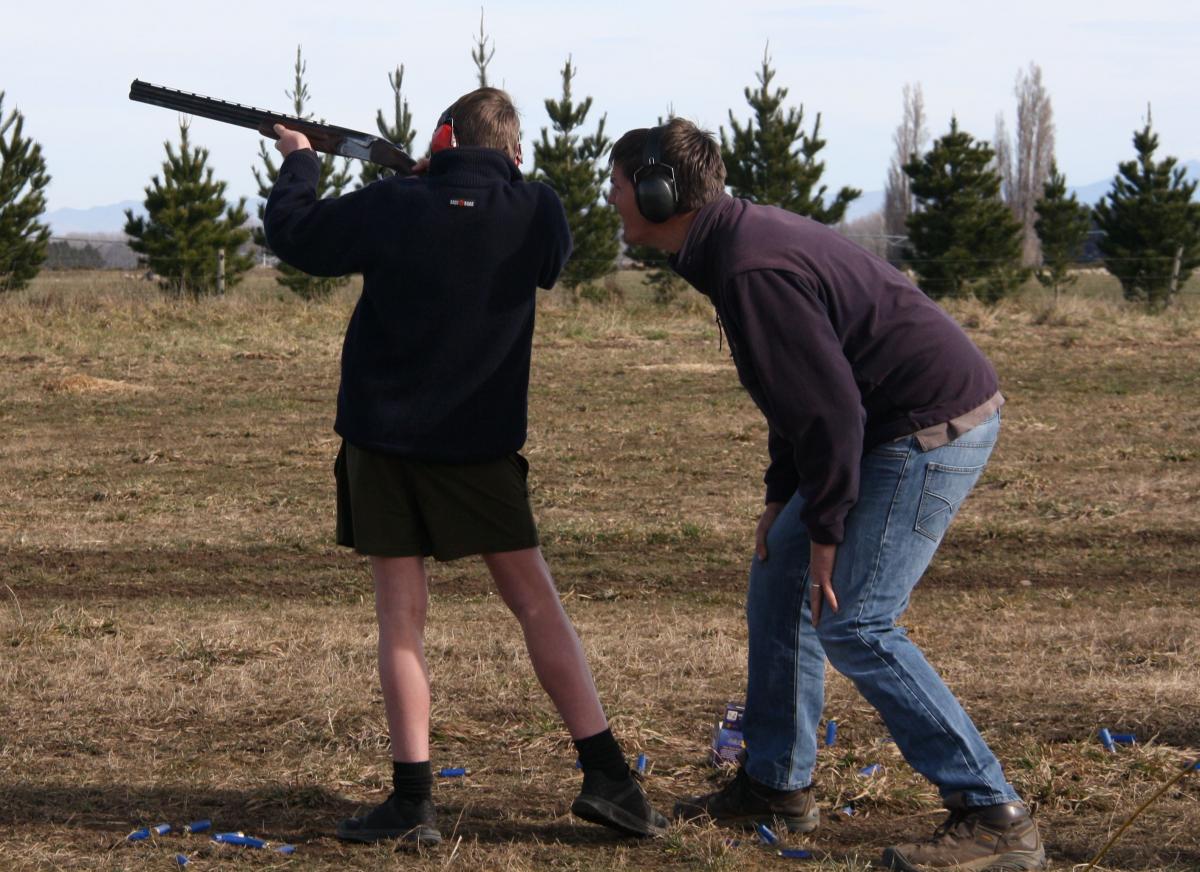Both Barrels South Island Roundup Aug 2016
- 25/08/2016
NELSON / MARLBOROUGH REGION
SHOVELER MONITORING RESULTS
Staff were recently out counting shoveler (kuruwhengi) as part of a nationwide monitoring campaign which has been taking place for well over a decade.
Shoveler in all 12 Fish & Game regions were counted simultaneously on August 8 in order to monitor distribution and population changes over time.
It is evident that the shoveler population nationally is increasing, with a total amount 14,133 shoveler counted in 2015, up from the previous years’ total of 13,554 birds, and 11,815 birds counted in 2013.
At the time of writing, however, the results of the 2016 count were still being collected and processed.
For Nelson / Marlborough, the total count from this year’s monitoring was 1849 birds, slightly lower but similar to last years’ results (see graph).
Shoveler are a highly mobile species and large fluctuations in their population are very normal.
 WAKAPUAKA PUKEKO HUNT WRAP
WAKAPUAKA PUKEKO HUNT WRAP
There was a good turnout for the Annual Pukeko Hunt at Wakapuaka, which was held on the penultimate weekend of the gamebird season.
Despite bleak weather conditions, around 55 hunters turned up for the event, including a number of hunters from Marlborough.
 This was the third year the hunt has been held, which has seen the total harvest go from 400 two years ago, to 300 in 2015, to this year’s harvest of 200 birds.
This was the third year the hunt has been held, which has seen the total harvest go from 400 two years ago, to 300 in 2015, to this year’s harvest of 200 birds.
This is good news for local farmers who asked for this hunt in order to reduce the agricultural impact the pukeko is having.
Staff spent part of the following day dressing out the birds, which are currently getting processed into salami.
It was particularly pleasing to see a good number of young hunters join us on the hunt.
Staff wish to thank to all who attended, particularly those who brought along juniors.
Holly Irvine pulled off a fine shot to bring down this pukeko.
F&G SUBMISSION ON RABBIT ISLAND
Fish & Game staff submitted on the draft Rabbit Island/Moturoa Management Plan, asking for access to the eastern end of the island for three weekends per year for pheasant hunting.
This half of the island is normally closed to the public as it's a forestry operation, so we believe the request for limited hunting on set days organised by Fish & Game is a reasonable one.
 It appears there has been some misinformation that the proposed hunting would take place at the western end, which is open to the public for recreation all year.
It appears there has been some misinformation that the proposed hunting would take place at the western end, which is open to the public for recreation all year.
This is not the case at all: our submission detailed a controlled form of hunting organised by Fish & Game staff for local pheasant hunters, which would be safe and with no impact whatsoever on wading birds (using setbacks away from the coastline – see map).
Right: The proposed hunting area is at the eastern end of Rabbit Island, which is closed at all times to the public.
Pheasant hunting opportunities have diminished in recent years in the Waimea area, so staff see this as a good opportunity to be able to provide licenceholders with additional areas for safe pheasant hunting.
Hopefully the Tasman councillors making the decision agree.
PUKEKO SEASON ROLLS ON
Hunters are reminded that the pukeko season continues in Tasman/Golden Bay sub area until 31 October.
WEST COAST REGION
Reports from local hunters have been varied for the 2016 game bird season, some have reported that there were less birds in their favoured spots during the season, while others found good concentrations of birds tucked away, that provided some good hunting.
There certainly appeared to be more ducks about later in the season.
The hunter harvest survey suggests that the estimated total harvest for all species was slightly below that of the 2015 season, particularly for paradise shelduck.
Hunter effort was down by an average of two hours per hunter, however there was an increase in the total number of game bird hunters within the region.
PREPARE FOR NEXT SEASON OVER SUMMER
Often knowledge and experiences gained from one season's hunting can provide hunting opportunities in future years.
Sometimes seemingly unproductive hunts, watching birds pile into a pond two paddocks away or heading over distant trees into a river backwater instead of your decoys, provide clues to a good hunting spot for next year.
The summer months are the ideal time to be looking into these areas and establishing new maimai sites while the conditions are drier and the surrounding water levels are down.
A well-concealed West Coast maimai.
If you have a maimai you shoot every season, why not undertake some predator control to improve the breeding success of the birds in your area.
It is clear that predators have an impact on duck populations so a few stoat boxes with DOC traps would be useful.
Set these along any animal runs through the grass next to your pond, or along habitat/scrub edges that predators are likely to move through.
Try using fresh rabbit and fish meal as bait for drawing them to the trap. Be sure to have your traps placed within stoat boxes to avoid non-target captures.
Summer is also a good time to be painting up any faded decoys.
Paul Stenning wrote a great article in the NZ Hunter magazine a few years ago on painting decoys.
Last season I used some low gloss spray paint from Mitre 10 to touch up a few decoys and found it especially useful for some of the hen ones.
Put in the work during summer and you should improve your prospects for the season ahead.
JUNIOR PARRIE/PUKEKO WEEKEND
If you have some keen junior hunters in the family, don’t forget the West Coast junior weekend that has been added into the regulations guide for this season.
This is a great opportunity to get them out before next May.
It is set for the weekend of March 4th & 5th 2017, with a bag limit of 5 Paradise Shelduck and 5 Pukeko.
LOCAL GUN CLUBSIf you haven’t been shooting as well as you'd hoped this season, or you’re interested in meeting other keen waterfowl hunters, why not join a local gun club?
There are some brilliant local clubs that offer great facilities close to West Coast towns.
Not only is this a good way to improve your hunting come opening morning next season, it’s a lot of fun.
If you’re new to game bird hunting there is probably no better place to go to get started than such a gun club, with plenty of experienced hunters to offer advice.
This is the last Both Barrels for this year, we will be back again prior to next season with results from our game bird trend counts over the summer months and prospects for the 2017 gamebird season.
Right: The Grey Gun Club has excellent simulated field shoot facilities.
NORTH CANTERBURY REGION
DONT MISS THE SWAN COMP!
Sponsored by Hunting and Fishing Christchurch City, Tower Junction, Rangiora, and supported by the Christchurch Airport Authority.
North Canterbury Fish & Game is again holding a black swan hunting competition during the 2016 hunting season.
Some changes have been made following the 2015 competition to encourage increased hunter participation.
- The competition now runs from Opening Day 7 May to the end of the Area A black swan season, 25 September 2016.
- Additional official collection stations have been added. The three official sites are the Fish & Game office, 32 River Road Rangiora; Watkins Homekill Processing, 3 Burdons Road Burnham; Ellesmere Butchery, 79 High Street Leeston.
The majestic black swan is often one of the most under-harvested game birds and we're encouraging hunters to realise the value of this magnificent game bird.
The competition has many aims: firstly, hunters have the added focus of harvesting black swan through the season as a valued food source, with the added bonus of going into a prize draw which is a feature of the social side of the competition.
 Secondly, black swan feeding on crops is at problem levels, in the Lake Ellesmere/Te Waihora and Lake Forsyth/Waireka surrounding areas.
Secondly, black swan feeding on crops is at problem levels, in the Lake Ellesmere/Te Waihora and Lake Forsyth/Waireka surrounding areas.
Left: Target species...bagging yourself some black swans could land you some great prizes.
The competition is confined to the North Canterbury Fish & Game Region and runs strictly from 7 May to 25 September.
To enter, hunters need to present pairs of black swan legs tied together and frozen separately.
Legs will not be accepted in a solid block or in a decayed state, and will be inspected for authenticity. There is no limit to the number of entries per hunter, but hunters may only enter one section.
A current 2016 game bird hunting licence must be produced, and all swans must be harvested under current Fish & Game hunting regulations.
Entries will not be accepted from birds shot under special game bird control permits.
Although the prize draw has yet to be finalised, the basic format will be three categories with a lucky draw for each section.
There will be a main prize in each prize pool and other lucky draw prizes will also be added.There will be at least one semi-automatic shotgun in the prize pool.
Section 1: 1 – 10 pairs of Black Swan legs. Hunting prizes valued at $1200
Section 2: 11 – 30 pairs of Black Swan legs. Hunting prizes valued at $2000
Section 3: 31 – 50 pairs of Black Swan legs. Hunting prizes valued at $2000
Section 4: Lucky licence draw $500 gift voucher
(The prize pool and values are approximate only and may differ from the above.)
To enter the competition pairs of legs will be accepted at the three sites outlined above.
Legs will only be accepted during a four day period during the last week of the Area A black swan season, starting Monday 19 September and finishing Thursday 22 September, 8.30am to 5pm.
Hunters are invited to attend a closing day social BBQ and prize draw at the Coes Ford/Selwyn River picnic area, Ellesmere, 11am Sunday 25 September.
It is very important that hunters attending the prize giving are able to produce both a Firearms Licence and a 2016 Gamebird Hunting Licence.
LAKE ELLESMERE CLEAN UP UNDERWAY
Derelict maimais and rubbish on Canterbury’s Lake Ellesmere have met their match with Fish & Game staff removing them as part of a long running annual programme of environmental enhancement work.
The maimais are used for hunting waterfowl and each year, Fish & Game staff spend a week on Lake Ellesmere or Te Waihora each year removing abandoned derelict maimai, as well as rubbish and debris.
In 2002, the North Canterbury Fish & Game Council joined forces with Ngai Tahu and DOC when a management plan for Lake Ellesmere was established.
As part of this plan, Fish & Game signed up to a Maimai Management Agreement which sees the organisation manage maimais on the lake more closely than in the past.
This management involves removing all abandoned or derelict maimais from the lake bed as well as contributing to a dedicated fund administered by Ngai Tahu, DOC and Fish & Game which used to fund habitat and enhancement projects on the lake.
The “Joint Management Fund” is paid for by game bird hunters, with 50 percent of the adult game bird hunting licence fee for each registered Ellesmere maimai on the lake.
This “Joint Management Fund” is administered by the DoC, Ngai Tahu and Fish & Game and used to fund habitat and enhancement projects on the lake.
Since removal of derelict maimais began in June 2002, nearly 700 have been removed from the lake.
The derelict maimais are removed using a barged digger towed behind a jet boat.
This has proved to be a very successful method, resulting in virtually no adverse environmental effects and has greatly improved aesthetics and safety for lake users in this portion of the lake.
At the same time as the maimais are pulled down, debris such as dumped car wrecks, tree stumps and old posts are also removed, an environmental enhancement project paid for by the maimai levy.
“It seemed sensible to remove other debris at the same time as the maimais, to further enhance the safety and aesthetics for lake users,” says Fish & Game North Canterbury Field Officer Steve Terry.
“Among the unsightly rubbish we have taken away are a thousand old tyres which had been placed around the mouth of the Halswell River many years ago by local farmers to minimise lake shore erosion,” he says.
“These were no longer effective for minimising erosion and were scattered over a 750m stretch of lakeshore to the west of the Halswell River mouth.”
Other projects underway include improving the public access to the lake.
“Overall, these projects have proved very successful and have significantly improved the areas of lake concentrated on so far, Fish & Game North Canterbury General manager Rod Cullinane says.
“Public awareness of the management plan process to clean up the lake has also improved, with reports that some hunters have taken responsibility and removed some of the derelict maimais themselves.”
Fish & Game’s clean up efforts have been positively received by other lake users.
CENTRAL SOUTH ISLAND REGION
The traditional game bird hunting season has drawn to a close in the Central South Island Region and the upland game season finished 28 August. But last and not least, the paradise shelduck season (West of SH1) closes on the 25th of September, 2016.
The final game harvest phone survey will be completed when the paradise shelduck season closes, so don’t be surprised if you get one last call survey call.
Please be aware the that the phone survey questioners aren't Fish & Game officers, so any burning questions you have for Fish & Game are of course much better answered through a phone call to the team at our Temuka office.
HARVEST SURVEY RESULTS
Thank you to all the hunters who have participated in our annual phone survey of so far.
We have been working on the 2016 game bird season information and can share a few notable results with you for our most popular game birds species; mallard and grey duck.
Because these birds hybridise and can be mistaken for each other we combine their harvest information and label them ‘greylards’.
For 2016 we have seen an improvement in greylard harvest in the CSI compared to 2015. CSI licenceholders harvested approximately 45,000 greylard for the 2016 season.
This is an almost 7,000 bird increase on the 2015 season. On average hunters harvested 18 greylards each, compared to around 16 each for 2015.
In 2016, for every hour spent hunting, hunters, on average harvested 1.5 birds (mathematically speaking) which is an improvement on the 2015 harvest rate of 1.3 birds per hour hunted.
For a longer term comparison, the 2016 greylard harvest was slightly below average considering the last 10 game bird seasons.
The 10 year average whole season greylard bag is 22 birds each with a harvest rate of around 1.6 birds harvested for every hour spent hunting.
TRAIN EM UP!
 Fish & Game once again teamed-up with the South Canterbury brannch of the NZ Deerstalkers Association to deliver a game bird hunting training day to participants completing the Associations ‘HUNTS’ hunter training course.
Fish & Game once again teamed-up with the South Canterbury brannch of the NZ Deerstalkers Association to deliver a game bird hunting training day to participants completing the Associations ‘HUNTS’ hunter training course.
Fish & Game Officer Hamish Stevens instructs clay target shooting.
The course participants were given an in-class presentation on all things game bird hunting and species management.
This included waterfowl species I.D., how to best use the different decoy types and an overview of game bird population monitoring surveys.
This was followed with a simulated field shoot where participants were able to practice the fundamentals of shotgun shooting, and test their skills on incoming and outgoing clay targets.
To learn more about the HUNTS course click here to link to the New Zealand Deer Stalkers Association Website.
PLAN AHEAD FOR SUMMER
Your 2016 game bird hunting licence is valid right up until the 2016-2017 summer hunting season.
On two weekends (4,5 & 11,12) in February 2017 there is an open summer season for mallard duck and paradise shelduck in the Central South Island Fish & Game Region.
The open season doesn’t cover the whole region so please refer to you 2016 regulation guide to clarify where you can hunt and bag limits.